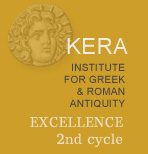Main Site . Other insciptions from the main site of Boubon
5 10 |
Αὐρ(ηλι-) Εὐτυχί[δ-?] μνήμης χάριν Κερελλαῖος μαντιάρχης ταῦτα λέγει: οὐ κακόν ἐστι τὸ θανεῖν, ἐπεὶ τό γε Μοῖρ′ ἐπέκλω– σεν, ἀλλὰ πρὶ[ν] ἡλικίης καὶ γον[έ]– ων πρότερος. |
... in memory. Caerellius (?) the chief diviner says this: death3 is not an evil (in itself) - for this is what destiny designed - but (death) before maturity and earlier than one's parents.
Round funerary column with relief depicting a standing youth raising his right hand, found and documented in Boubon (no further specification) by Kalinka in 1895. The stone seems to have been lost since.
Height: 89 cm; diameter: 50 cm; letters: 2.5 cm.
Heberdey and Kalinka 1897, p. 40 no. 58; Guarducci 1949, pp. 118-121; Pasquali 1950, pp. 351-352, Robert, BullÉp 1951, no. 24; 1952, no. 17; Guarducci 1952, pp. 340-345; Robert, op. cit. 1954, no. 31; Peek 1955, no. 1665; Schindler 1972, no. 35; Robert, op. cit. 1973, no. 462; Drew-Bear 1979, pp. 311-312; Milner 1998, p. 3, no. 1.36; Merkelbach and Stauber 2002, no. 17.2.1.
L. 1 : For example Αὐρ(ηλίῳ) Εὐτυχί[δου]. An alternativ reading of this line might be Αὐρ(ήλιε) εὐτύχι, on which see Robert 1949, pp. 198-199 and the commentary to no. 35.
L. 3-5 : Κερελλαῖος might be the rendering in Greek of a Latin cognomen of Etruscan origin Cerealis or Caerellius (Pasquali, Milner). "Chief diviners" are attested in Cyprus (see Guarducci 1952, p. 341) and Ephesos (IK Ephesos 1044, l. 20; Robert, BullÉp 1961, no. 539). This "diviner" is more likely to have borrowed the famous verses than to have been the author of them (Pasquali; cf. Drew-Bear).
L. 6-11 : This is a recurring theme in Greek epitaphs, on which see Guarducci 1949, p. 119; Peek 1955, nos. 1663-1669; Lattimore 1962, pp. 184-185; Vérilhac 1982, pp. 149-153.

